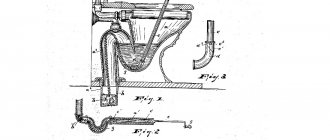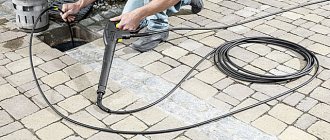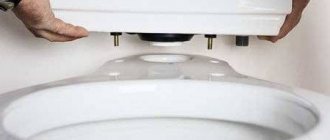FUM tape is polymer elastic strips of different widths and thicknesses made from F-4 fluoroplastic. Strips of various lengths are wound on bobbins in the form of coils. They are used for sealing threaded connections of pipelines and when connecting plumbing fixtures. Sometimes glue or lubricant is included with the reel. “Plumber Portal” will tell you how to correctly select and wind a fluoroplastic sealant to obtain a reliable and tight connection.
What is fum tape, types and application
Fum tape (fluoroplastic sealing material) is nothing more than a rope rolled out to a width of 10 or 16 mm, made of fluoroplastic-4. The addition of fluorine can significantly improve the mechanical characteristics of the sealant, increase its service life and resistance when in contact with aggressive chemical compounds. PTFE sealing strips retain their performance properties at temperatures from -70 to +2700C.
The main document regulating the chemical composition, mechanical characteristics, dimensions and scope of application of synthetic tape seals is GOST 24222-80.
There are three main modifications of fum tape:
- FUM-1
. The sealant is used to ensure the tightness of pipelines and general purpose highways. The material is resistant to active chemical elements and compounds, the melting temperature is 510 – 5200C. The peculiarity of this type of sealing tape is the presence of a lubricating ingredient (vaseline oil). - FUM-2
is intended for sealing threaded connections operating in constant contact with active oxidizing agents and oxygen. No lubricant is used. Sometimes the tape is used to work with gas pipelines, so it is often painted yellow. - FUM-3
is usually used as the edge part of the FUM-1 and FUM-2 seals because it is highly resistant to various oxidizing agents and aggressive compounds.
The correct choice of FL modification will ensure the tightness of the threaded connection for a long time.
Scope of application
To manufacture the FUM seal, a synthetic polymer, polytetrafluoroethylene (fluoroplastic F-4), obtained by chemical synthesis, is used. Initially, fluoroplastic looks like white flakes, but during the process of thermal and chemical treatment, the raw material is sintered and pressed, forming an elastic fabric.
Due to their chemical and physical properties, fum strips are widely used in various household areas for hermetic insulation of threaded connections:
- Water supply and heating systems. Fluoroplastic tapes are used for connecting plumbing fixtures, heating radiators, and connecting pipes. Due to its water resistance, FUM is used when organizing external water supply from HDPE pipes and for hermetically sealing polymer fittings.
- Gas lines. Since fluoroplastic does not allow gases to pass through, it is used to provide reliable protection against leaks in gas lines. When connecting household gas appliances, cylinders and metering devices and other equipment, this tape seal is also used.
- Automotive technology. Due to its high degree of thermal and chemical resistance, fluoroplastic tape is used for repairs of any type of technical equipment. The tape sealant is also resistant to automotive fuel and oil.
As a rule, FUM tape is produced in white for water supply networks and in yellow for gas pipelines.
The product also differs by brand and grade, depending on its technical parameters and physical properties. A specific type of tape seal is designed for different conditions, where it will be most effective. Therefore, when choosing fum tape, you should pay attention to the color and technical characteristics in order to buy a product suitable for a specific type of installation work.
Properties and technical characteristics of fum tape
The main operational parameters are presented in the table:
| Options | FUM-1 | FUM-2 |
| Thickness, mm | 0,1 – 0,15 | 0,035 — 0,25 |
| Width, mm | 10 — 60 | 5 — 60 |
| Elongation at break, % | 100 — 200 | 100 |
| Availability of lubrication, % | up to 20 | — |
| Allowable breaking force, kg/cm2 | 40 | 60 |
The main advantages of fum tape include:
- Availability and low cost;
- Efficiency and ease of installation;
- Possibility of dismantling even after long-term use;
- Can be used for working with plastic threads.
It should be noted that there are some disadvantages inherent to fum sealants:
- Insufficient sealing of large diameter pipelines;
- Significant temperature changes can break the seal;
- It is undesirable to seal joints subject to vibration;
- Loss of tightness even with slight loosening of the tightening.
However, despite the above disadvantages, proper use of fum will ensure tightness for a period of 10 years or more.
How to properly wind fum tape onto a thread
The correct winding of the FL is crucial for the tightness of the connection. To ensure sufficient connection density, you need to follow a few simple rules.
- Clean the threaded profile from dirt and traces of corrosion, then degrease it with gasoline or other organic solvent. Wait until the surface is completely dry.
- When winding, the tension of the tape should ensure that it fits snugly against the thread. In case of a break, the edge is smoothed tightly to the thread and winding continues, overlapping the break point by 10-15 mm. If the length of the thread exceeds the width of the tape, winding is carried out with an overlap of the previous turn by 5-7 mm.
- After winding is completed, the end of the fum tape is smoothed tightly so that it does not interfere with screwing.
Important!
When the thread is in the right direction, the tape is wound clockwise, and when it is in the left direction, it is wound counterclockwise.
After screwing, even a slight loosening can lead to loss of tightness. If the number of revolutions is chosen incorrectly, you should disassemble the connection, clean the threads from any remaining sealant and repeat the winding.
Sealing threads using fum is not a complex technological process, but it requires practical skills and care.
Features of use
Despite the ease of working with the material, fum tape must also be applied correctly, otherwise it will be impossible to achieve perfect sealing. The work is performed in the following sequence:
1. The joints are prepared. This involves removing all dirt and rust present from the threaded connection. To do this, it is better to use a wire brush. After this, it is recommended to degrease the threads. Then the tape will not slip during the winding process. The connection is wiped with gasoline or some other solvent. After drying, work can continue.
2. The fum tape is wound onto the thread clockwise, exactly in the direction in which we will screw the connecting pipe onto the thread.
Tip: During the winding process, the tape should not be pulled too vigorously, as it may become deformed or break. It’s also not worth giving slack, since the turns should be tight.
3. The number of layers of wound tape depends on the diameter of the connection and the thickness of the tape itself. The larger the diameter and the thinner the seal, the more turns will need to be made. For example, to seal a pipeline with a diameter of 30 mm, it is necessary to make at least 3 turns. And for a diameter of 40 mm you will need at least 4 turns. The larger the diameter of the connection, the deeper the thread. It is the voids between its turns that need to be filled as much as possible.
4. If it turns out that the connection is leaking, then the tape winding procedure must be repeated. To do this, the connection is disassembled, the remaining tape is removed, after which a new sealing material is wound. Of course, the number of turns needs to be increased. It is not allowed to wind a new tape on the remains of the old material, as the tightness of the connection will not be ensured.
We can conclude that fum tape is a very convenient, safe and technologically advanced material that can be successfully used in most situations. The sealed connections obtained with its help are durable and reliable.
Fum tape is an unfired fluoroplastic film. Its main purpose is to seal threaded connections, ensuring tightness
. In addition, the material has high chemical and thermal resistance.
Fum tape is widely used not only in everyday life, but also in many industrial sectors such as construction, medical, pharmaceutical. There is no way to do without this tape in the plumbing industry.
To ensure reliable sealing of threaded connections, no special knowledge or experience is required. And, nevertheless, there are a number of rules, compliance with which will ensure the high quality of the work performed.
How much fum tape to wind on the thread
There is no definite answer to this question, since the number of turns and the thickness of the layer of fluoroplastic tape sealant is determined exclusively experimentally. Below are some recommendations:
- The tape is wound until the entire surface of the thread is hidden. The surface must be flat, and the protrusions must be visible through the sealant layer;
- The number of turns is directly related to the diameter of the threaded connection and the depth of the thread, since to ensure tightness it is necessary to fill the gaps between the groove and the protrusion of the thread;
- Approximately, for pipes with a diameter of 10 to 25 mm, 7-10 turns are wound, from 25 to 40 mm, 13-15 layers of fum tape will be required.
- In addition to the design dimensions, the condition of the thread, the degree of wear, and the presence of mechanical and erosion damage should be taken into account.
The best seal
This synthetic material will reliably protect connections from leaks.
To do this, you must follow certain rules.
INTERESTING
. Fluorine, which is part of the material, provides strength and heat-resistant properties.
The tape does not tear, does not stretch, and does not react with active substances.
And most importantly, after installing sanitary ware (read whether sanitary ware or porcelain is better), it does not lose its properties over time.
What can be used instead of fum tape
The main competitors of fluoroplastic seals can be considered:
- Natural flax (sanitary tow). The material has been used for a long time and has proven itself to be a reliable and inexpensive product. Linen can be used either without additional processing or in combination with various plumbing mastics and even oil paint.
- Polymer thread is used to seal threaded connections with a small number of turns.
- Anaerobic sealant is quite expensive and is used, as a rule, for particularly critical connections.
The main disadvantage of fum tape is the loss of tightness of the connection even with slight twisting, however, if calculated correctly, loosening will not be required. In terms of performance characteristics, fum tape provides reliable thread sealing even at high temperatures (up to +5200C) and direct contact with aggressive media. The availability and ease of sealing using fluoroplastic tapes have ensured their widest popularity.
Comparison with tow
Tow based on flax fiber is one of the widely used materials for sealing threaded connections, however, FUM tape in many cases replaces tow due to the following advantages:
- Unlike flax fiber, which must be protected from moisture by painting or water-repellent putties, fluoroplastic is waterproof and does not require the use of additional consumables when winding on a joint.
- The process of winding strips is characterized by simplicity, convenience and high speed of work.
- Tow disrupts the aesthetics of the joint, it protrudes beyond the joints and looks sloppy when painted. Thin fum stripes are practically invisible and do not interfere with the decorative effect of the connecting unit.
- Linen, when saturated with water, begins to rot and collapse; fluoroplastic polymer is devoid of this drawback and can last 10-15 years without losing its physical and chemical properties.
- The connection with fluoroplastic sealant is quickly removed and easily demonstrated, unlike flax fiber. When using a FUM insulator, after dismantling it, there is no need to clean the threads and the surface of the elements being connected.
- When using tow, you need to apply significant physical effort and special tools, which often leads to deformation of the surface of fittings, adapter couplings, and union nuts. Fluoroplastic, due to its plasticity, allows you to connect elements without much effort simply by hand.
- Polymer insulator is easy to purchase at a hardware store, while tow is not available everywhere. In terms of price, both materials are approximately the same.
At the same time, the significant advantages of FUM tape cannot completely replace flax fiber for the following reasons:
- The strips are very thin and tear easily. When wound onto a metal thread, the surface of the polymer is damaged by sharp edges and the tightness of the connection is broken. Therefore, FUM tape is not recommended for use on triangular metal threads with sharp teeth.
- Fluoroplastic is more demanding on the thickness of the winding layer. If there is an excess of layers, the surface of the insulator breaks, while the tow simply becomes compacted.
- Despite its thermal stability, polymer sealant is not recommended for use in heating systems with a steel circuit, since as a result of thermal expansion, the winding is strongly compressed or squeezed out of the thread, and after cooling the joint loses its tightness.
- It is prohibited to use the FUM seal when connecting fittings subject to constant vibration.
When using FUM tape, you should understand that it is most suitable for sealing threaded fittings made of polymers, with metal trapezoidal and rounded threads. However, its use is excluded when assembling steel pipelines with triangular threads.











